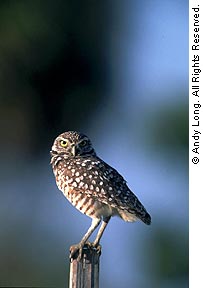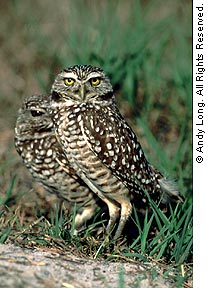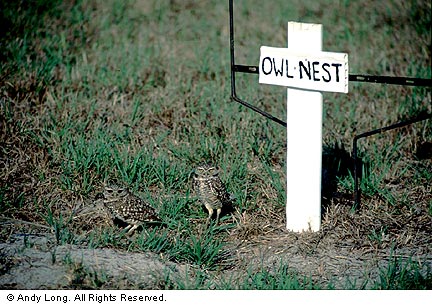 Ask anyone to describe an owl, and he’ll most likely say owls are large birds that can be found either high in trees or in the rafters of an old barn–if you can find them at all, because they’re primarily nocturnal. Such a description would be correct for most types of owls, but it would be far from the truth for burrowing owls.These small owls, measuring about nine inches tall, are unique in that they spend almost their entire lives on or in the ground. In fact, they even use underground cavities for nesting. They often use holes already excavated by prairie dogs or badgers. In areas in which such reluctant realtors don’t provide pre-built homes, the owls will dig their own holes.
Ask anyone to describe an owl, and he’ll most likely say owls are large birds that can be found either high in trees or in the rafters of an old barn–if you can find them at all, because they’re primarily nocturnal. Such a description would be correct for most types of owls, but it would be far from the truth for burrowing owls.These small owls, measuring about nine inches tall, are unique in that they spend almost their entire lives on or in the ground. In fact, they even use underground cavities for nesting. They often use holes already excavated by prairie dogs or badgers. In areas in which such reluctant realtors don’t provide pre-built homes, the owls will dig their own holes.
Another difference between burrowing owls and their larger relatives is that if you find one burrowing owl, you’re more than likely to find several others in the vicinity.This is true not only because the females lay upwards of eight to nine eggs, but also because burrowing owls nest in scattered colonies of four to five families. However, although they may occupy several nests in a single area, they don’t demonstrate communal behavior and stay pretty much to themselves.
A third feature that sets these animals apart from their brethren is that they’re primarily daylight hunters, making it easy to find and photograph them if you locate an area where they’re active.If you do come upon burrowing owls, you’ll need to change your ideas about how to determine if the bird you’re looking at is male or female.While the female is the larger of the two in all other owl species, the male is the larger of the two among burrowing owls.
When you examine burrowing owls further, you’ll notice that they have longer legs than other owls.They use these both for excavating a burrow and for getting around on the ground, where they spend most of their time. In fact, they do most of their hunting on the ground–looking for insects, small reptiles, and rodents.
 And don’t think that because these are tiny birds, they can’t be a nuisance. One woman in southwestern Florida discovered the sad truth firsthand. Anyone who has gone to Ding Darling to photograph the birds that winter in the area knows about the numerous burrowing owl sites near Cape Coral.Showing their adaptability, the small owls have taken up digging their burrows into peoples’ front yards.During one particular nesting season, one of the chosen yards belonged to a woman who began to deplore the protective nature of the burrowing owl adults. Every time she ventured out of her house, she would be attacked–mainly by the mother of the newborns.She had to resort to using an umbrella to protect herself as she went out to get her mail. After several calls to different authorities, she found out that because burrowing owls are on the protected species list, no one could intervene in the situation. She was told that her problem would solve itself once the newborns fledged and left the nest site. She would have to be patient. After that, if she so wished, city officials would try to obtain a permit to move the owls to another nest site in town. If only the victimized woman had been a photographer! She could have been outside morning, noon, and night, documenting the nest.
And don’t think that because these are tiny birds, they can’t be a nuisance. One woman in southwestern Florida discovered the sad truth firsthand. Anyone who has gone to Ding Darling to photograph the birds that winter in the area knows about the numerous burrowing owl sites near Cape Coral.Showing their adaptability, the small owls have taken up digging their burrows into peoples’ front yards.During one particular nesting season, one of the chosen yards belonged to a woman who began to deplore the protective nature of the burrowing owl adults. Every time she ventured out of her house, she would be attacked–mainly by the mother of the newborns.She had to resort to using an umbrella to protect herself as she went out to get her mail. After several calls to different authorities, she found out that because burrowing owls are on the protected species list, no one could intervene in the situation. She was told that her problem would solve itself once the newborns fledged and left the nest site. She would have to be patient. After that, if she so wished, city officials would try to obtain a permit to move the owls to another nest site in town. If only the victimized woman had been a photographer! She could have been outside morning, noon, and night, documenting the nest.
When photographing burrowing owls, one of the most fun things to do–if you’re close enough for full-frame images of individuals–is to get a shot of the owls spinning their heads.Keeping their bodies perfectly still, they’ll quickly turn their heads from side to side in a quick motion–to scan the area. This trick can present a unique image. However, taking such a shot may put your patience to the test. (Although I’ve seen pictures, I haven’t been able to capture the behavior myself.)
Another tip when shooting these birds:Try to stay as low to the ground as possible.By keeping a low profile–preferably by sitting or lying on the ground, you don’t pose such a big threat to them.Plus, this puts you at eye level with the birds, a perspective you should seek to accomplish with all wildlife subjects, if possible, but especially with animals whose size and location put them close to ground level.
The account of the attack owls is not the only interesting story about burrowing owls to come out of Florida.Three pairs of burrowing owls have nested outside Plantation, Florida, at the Motorola plant for many years. But, unlike the lady in Cape Coral, the people at the plant do all they can to provide a good home for the owls. Each year during nesting season, the plant workers rope off the burrows in order to protect them. However, they frequently seal the burrows after the nesting season if they’re located in places that create a safety hazard or other facility conflict. To aid in the owls’ search for new burrows on the property, two-foot circular plugs of sod are removed from the lawn to encourage them to relocate to those spots.Workers also place tee-perches next to the area and restrict use of pesticides near the burrows to make sure the owls have safe and comfortable homes.

VOCALIZATIONS – When you think of the sounds made by owls, the typical “who-who” is what comes to mind first.But, if you were in an area populated by burrowing owls, you’d be surprised by the variety of sounds coming from their holes.They’re capable of producing almost twenty different vocalizations. These vocalizations occur primarily during mating and nesting.Adult males will call out at the entrance of a burrow to attract a female.Once the female has been enticed, courtship antics involving various postures, vocalizations, and displays ensue–performed by both sexes, usually close to the burrow.Some of these sounds have been described as the “rasp,” “chuck,” “chatter,” and “scream.”Juveniles give a rattlesnake-type buzz when threatened in the burrow.This alarm sometimes carries over to adulthood when the tiny owls that feel threatened are in the burrow and wish to try to trick predators into thinking a rattlesnake is in the hole.
HOT SPOT – If you go to Ding Darling during the first part of the year, a good place to find burrowing owls is in the town of Cape Coral.One spot is on Cape Coral Parkway and Palm Tree.There is an open field on the south side of the Cape Coral Parkway, about one mile after crossing Del Prado.Another place to check out is the subdivision west of the Cape Coral Shopping Center on Del Prado.Drive around these locations and look for wire frames placed at the borrows for perches.
By Andy Long

Leave a Reply